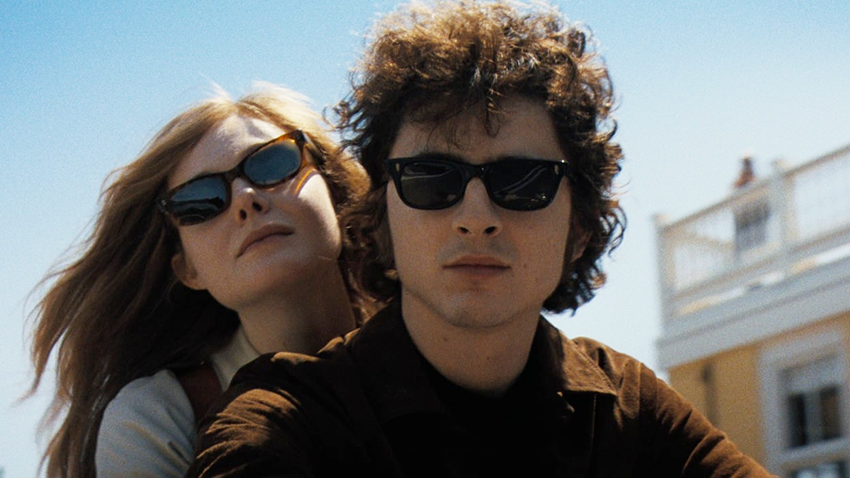A Complete Unknown is a brilliant title for this new Bob Dylan movie, working on multiple levels. The film opens with Robert Zimmerman, now styling himself as Bobby Dylan, arriving in New York as a complete unknown, in wintry grey-and-brown scenes reminiscent of the Freewheeling Bob Dylan album cover. He has come to see his idol Woody Guthrie, dying of a degenerative brain disease in hospital, not only to pay tribute but to get some blessing on his songs and ambition to be better known.
Here he also meets Pete Seeger, champion of folk music and the Newport Folk Festival, who recognises Dylan’s talent. Ed Norton, playing Seeger, captures his gentleness and paternalistic optimism and generosity. In modern movies we expect high levels of verisimilitude, and the other characterisations are great too. Timothee Chalamet (who also produces) replicates the heavy-lidded sideward glances, the shuffling, slightly shy, intense Dylan – serious, ambitious, witty but guarded.
Elle Fanning plays Dylan’s long-suffering girlfriend Suze, here renamed ‘Sylvie’ apparently on Bob’s somewhat odd request. (Didn’t you think we’d guess, Bob?) Suze/Sylvie’s face is stretched by sadness – pride in his achievements, as she pushes him to record his own songs, but also fighting with the knowledge he won’t stay or that he’s too big for her grasp. She is not so much jealous, but sad at her inability to keep his full attention or compete with Joan Baez and growing fame, and it shows all over her face.
Monica Barbaro plays feisty Joan Baez, already a star and the rival for Dylan’s affection, a folk singer with an operatic voice that Dylan calls ‘too pretty’ but to whom he gives a number of his songs. Chalamet and Barbaro recreate the on- and offstage chemistry.
The film is about the early years of Dylan’s career when he went from complete unknown to the voice of the protest generation and something of a folk revivalist. It also pivots on his decision to ‘go electric’ and play with a band. (The film is loosely based on a book, Dylan Goes Electric.) The infamous 1965 Newport performance is the film’s culmination, and the film creates tension through his peers not knowing which way his career will head. Seeger wants to keep him championing the old ways, but the impetuous and peripatetic Dylan wants to keep moving.
Although the film conflates real-life scenes and simplifies history for the sake of a tighter narrative, there is attention to detail in the sets and performances (and little nuggets for those more familiar with the story, such as guitarist Al Kooper playing organ on ‘Like a Rolling Stone’), and we are given generous chunks of songs to slip inside them, to open the magical door and into the blazing lines that come one after another like waves.
Twice the hair on the back of my neck stood up – during two moments emblematic of his shift – once when he introduces ‘The Times They Are A-Changing’ to the 1964 Newport crowd, who soon get the hang of it and sing along, and during the opening ascending chords of ‘Like a Rolling Stone’, with which Dylan stubbornly beats the Newport crowd the following year.
The film’s title is taken from ‘Like a Rolling Stone’. (An entire book has been written about the recording of this one song.) Interestingly, the line ‘like a complete unknown’ follows the line ‘no direction home’, the title of the 2005 Scorsese documentary. The recording and then live versions of the song were the catalyst for going electric; famously, the song followed a British audience member accusing him mid-concert of betraying the folk movement, caught on tape. The song is symbolic of the passing of the torch – or taking of the torch – from Guthrie and Seeger to Dylan.
The film is also about Dylan’s mystique, the unknowability to even those closest to him. To one girlfriend draped over his arm at a party who says she loves him, he replies that they only just met – the implication is not that he doesn’t know her (he doesn’t seem that interested) but that she can’t know him. And it is often noted that Dylan has done his utmost to remain an enigma to the general public.
To the two main female characters in the film, Dylan remains almost unknown. The camera lingers on Suze/Sylvie and Joan as their gaze lingers on Dylan, as they try to work out this inscrutable man. (It doesn’t help that Dylan is often mumbling. This is a film that could benefit from subtitles.) Both women are defined by their relationship to Dylan and the elasticity of their connection, controlled by Dylan. He takes pieces from them but doesn’t replace those pieces with his own.

This is Dylan’s downside – they are looking for some reciprocity, but Dylan keeps his secrets. Dylan says he doesn’t want to hear people’s back stories, and he doesn’t want to share his own, preferring instead the image of himself he is constructing. Suze/Sylvie jokes about him thinking he’s God – he’s building a mythology that hides the real Bob, the real Zimmerman. Both Suze/Sylvie and Joan tell him he’s a jerk, and he doesn’t disagree – his artistic muse is his focus, rather than them.
Nick Mattiske blogs on books at coburgreviewofbooks.wordpress.com and is the illustrator of Thoughts That Feel So Big.














